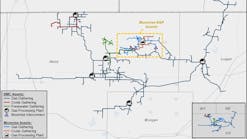The oil and gas industry continues to unlock greater resources both onshore and offshore—in shale formations and in deepwater. Growing production from these areas, particularly in the US, is the product of continuous innovation and the resources contained in both will play a critical role in meeting growing global energy demand.
These were some of the themes to arise during a May 5 panel discussion at the Offshore Technology Conference in Houston.
“The more we can cross-learn between the two segments, the faster we can improve,” said Torstein Hole, one of the panel members and a senior vice-president at Statoil ASA.
Hole said some technical aspects of shale development—such as research on rock mechanics and gas lift—have applications offshore as well.
David Eyton, group head of technology for BP PLC, added that companies can exploit technology synergies in areas “such as imaging, fracturing, sand consolidation, enhanced recovery, and artificial lift.”
Different approaches needed
However, operators must take different approaches to developing shale and deepwater resources due to the different nature of the reservoirs and the varying conditions present above-the-surface.
Shale development occurs onshore near population centers, requiring urban planning and greater public interaction. Shale is also characterized by fast-paced development using hundreds of wells, and a high degree of cost sensitivity.
Offshore development, meanwhile, calls for significantly longer project lead times, fewer wells, and significantly higher costs and risks.
Years of planning and preparation are required to bring a deepwater discovery online, but the potential payoff is much larger.
The resources extracted from a single shale well, represented in the form of estimated ultimate recovery (EUR), are relatively small compared with an offshore well. For onshore shale developments, “It is the collective wells in a region which constitutes a substantial prize,” said Doreen Chin, upstream surface advisor for Shell Exploration & Production Co., and Sandeep Khurana, senior project manager for Granherne Inc. The pair coauthored a technical paper for OTC that comparing shale to deepwater development.
Chin and Khurana wrote, “The motivation to consider deepwater investments includes the large resource sizes drainable with fewer wells and the resulting production with a longer payout profile.”
Eyton said deepwater is characterized by the sheer scale of individual developments with high upfront capital requirements. To be economical, he said, well productivities and drainage areas must be orders of magnitude greater than those for unconventional wells.
Shale wells, with their comparatively lower EURs, have much tighter margins than offshore wells and operators are keenly focused on lowing costs and becoming more efficient.
Darrell Hollek, a senior vice-president for Anadarko Petroleum Corp., said shale development is all about incremental economics. “If you can’t control your costs you won’t be an effective player in the onshore side,” he said.
Supply renaissance
The US is the largest producer of unconventional oil and natural gas in the world, and the US Energy Information Administration expects shale will help increase US oil production to 9.6 million b/d by 2016.
Lee Tillman, chief executive officer of Marathon Oil Corp., said both shale and deepwater are contributing to a US supply revolution. “Today we find ourselves in the midst of a supply renaissance,” he said.
Tillman said both shale and deepwater production are needed to meet the world’s growing energy needs.
Contact Rachael Seeley at [email protected].

